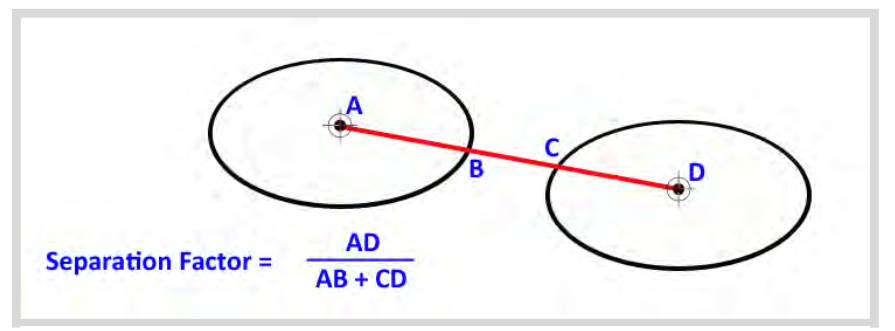Most clients will adopt a safety rule based on separation factor. Separation factor is the ratio of the “as surveyed” or “as planned” centre to centre distance of the wells divided by the uncertainty as to their actual
locations.

For most companies the rules will be similar to the following but in the absence of client guidelines the following should be adopted:
1. When the database is newly acquired or constructed, or when starting a new project, a scan of all wells in the field must be conducted.
2. Review this scan with a local field expert to verify:
a. All wells are present. (Be careful to verify plugged and abandoned exploration wells as well as wells drilled by other operators are included).
b. All wells are located properly. (The catalogue of errors that can occur when transferring a database is numerous but just two examples are: 1) incorrect platform location and 2)
transposing the inclination and azimuth values between the original data and the new database).
3. With a fully quality controlled database scan all wells that have even a remote possibility of being within the path of the planned well.
4. Report all sections where the separation factor falls to less than 4.0.
5. If the separation factor falls below 1.5 attempt to adjust the well plan. For many operators this is the approach limit that requires adjacent wells to be shut in whilst drilling the new well. This is not in itself a
risk free strategy since the pressures rise bringing their own hazards.
6. If the separation factor falls below 1.25 attempt to adjust the well plan. This is leaving inadequate room for directional drilling adjustments during the execution phase.
7. In certain cases, it will not be possible to plan the well without generating separation factors that transgress the limits in the two previous instructions. Most companies have a policy that in no cases
should a well be planned with a separation factor less than 1.0. There may be some dispensation policy in place that if the risk is merely fiscal and other mitigating steps are taken, permission may be given to
proceed but this should always be the last resort.
8. If it is impossible to plan the well without separation factors equal to or greater than 1.0 then a special dispensation to drill with a sub 1.0 separation factor must be granted by the client. The operator may
grant this dispensation in special cases. Examples cases might be; if the hazard well is one that is planned but not yet drilled, or perhaps in a case where circumstances like the following apply: (These are only
examples and by no means comprehensive).
a. The hazard well is protected by at least two layers of casing.
b. The angle of attack is less than 10 degrees.
c. The wells are equally pressured or the pressure difference is safely manageable.
d. The well cross sections make up less than 1% of the 1 sigma error ellipse.


Post your comment on this topic.